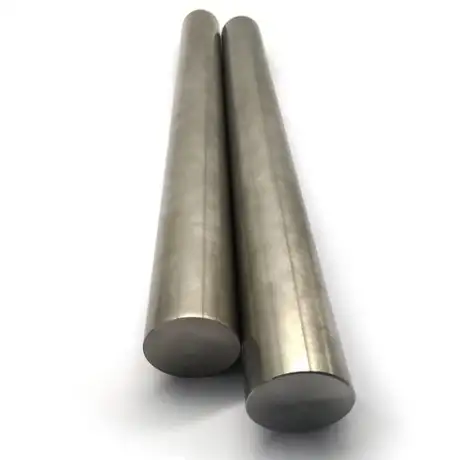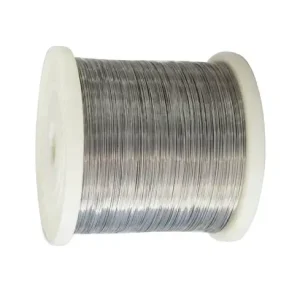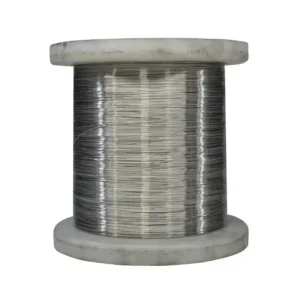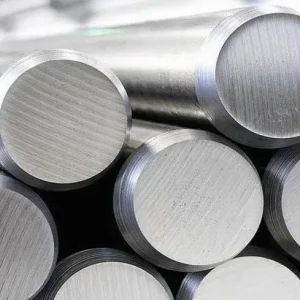Incoloy® 925 round bar (UNS N09925) is a precipitation-hardening nickel-iron-chromium alloy engineered for high strength together with strong resistance to pitting, crevice corrosion and chloride-induced stress corrosion cracking; it is particularly suited for sour oil & gas applications, down-hole components and high-duty pump/shaft parts where both strength and corrosion resistance are required. For buyers needing mill-quality bars with fast delivery from China, MWAlloys offers factory direct pricing, substantial stock, and rapid shipment terms, typically priced below western distributor levels while meeting ASTM/NACE qualification requirements.
1. What is Incoloy 925?
Incoloy 925 is an age-hardenable nickel-iron-chromium alloy containing deliberate additions of molybdenum, copper, titanium and aluminium. The chemistry and heat-treatment schedule enable the alloy to combine high tensile and yield strength with excellent resistance to general corrosion, pitting and chloride-induced stress corrosion cracking. That property set makes the grade a frequent choice for “sour service” oil and gas components, high-strength fasteners, pump shafts and valve parts where sulfide stress cracking (SSC) or chloride exposure is a risk.
2. Chemical composition (nominal ranges)
The table below shows typical compositional ranges used in vendor datasheets and ASTM/UNS references. Numbers are nominal and purchasers should request mill certificates for exact heat analysis.
| Element | Typical range (wt. %) |
|---|---|
| Nickel (Ni) | 42.0 – 46.0 |
| Chromium (Cr) | 19.5 – 22.5 |
| Iron (Fe) | Balance (~22% min) |
| Molybdenum (Mo) | 2.5 – 3.5 |
| Copper (Cu) | 1.5 – 3.0 |
| Titanium (Ti) | 1.9 – 2.4 |
| Aluminium (Al) | 0.1 – 0.5 |
| Carbon (C) | ≤ 0.03 |
| Manganese (Mn) | ≤ 1.0 |
| Silicon (Si) | ≤ 0.5 |
| Niobium (Nb, Cb) | ≤ 0.5 |
| Sulfur (S), Phosphorus (P) | ≤ 0.03 each |
This composition appears on manufacturer technical bulletins and supplier datasheets and is the basis for the alloy’s age-hardening response and corrosion performance.
3. Material properties (typical values and behaviour)
Density: ~ 8.05–8.10 g/cm³ (≈ 8,080 kg/m³).
Melting range: roughly 1,310–1,370 °C (dependent on chemistry).
Usable temperature: retains strength to ~ 540–650 °C under certain conditions; many applications use it at ambient to moderately elevated temperatures.
Corrosion: excellent resistance to chloride, sulfide environments and general oxidising/reducing media when compared with standard austenitic stainless steels. The alloy meets sour-service requirements in many heat-treat conditions.
Typical mechanical properties (representative — depends on condition)
Values vary significantly by whether the bar is solution-annealed, cold-worked or precipitation-aged. Below are representative ranges drawn from manufacturer and industry datasheets:
| Condition | Tensile strength (MPa) | 0.2% Yield (MPa) | Elongation (%) |
|---|---|---|---|
| Solution-annealed (soft) | ~ 685 MPa (min) | ~ 271 MPa (min) | ~ 50–60% |
| Aged / precipitation-hardened | 800 – 1,200+ MPa (typical range) | 550 – 850 MPa (typical range) | 20–35% |
Special Metals’ technical bulletin and independent datasheets report compression/tension results in the 800–1,200 MPa tensile window depending on aging schedule; a typical aged round bar can show tensile strength in the high hundreds to over 1,000 MPa. Use engineers’ qualification testing for design inputs.
Hardness and fatigue: hardness rises significantly after aging (Rockwell C increases); fatigue behaviour is good for a precipitation-hardened nickel alloy but must be validated for cyclic down-hole loading.
4. Standards, specifications and equivalents
Common industry references for Incoloy 925 include:
-
UNS: N09925 (primary designation).
-
ASTM/ASME: wrought bar/rod and fastener standards often use ASTM designations such as ASTM B637 / B805 or ASME equivalents for wrought products, forgings and specified forms. Confirm the specific ASTM number with supplier and certificate.
-
NACE MR0175 / ISO 15156: many datasheets note that Alloy 925 qualifies for sour-service environments under these guidelines (qualification depends on heat treatment and hardness limits). Where hydrogen sulfide or sour environments are present, use NACE/ISO guidance for selection and qualification.
-
W. Nr / DIN / GB: international cross-references exist (e.g., EN/WNr and Chinese GB/NS grades). Typical cross reference: W. Nr. ≈ 2.4858 / Chinese grade H09925 / UNS N09925 equivalence.
Equivalents: No single alloy is identical, but Alloy 925 is often compared with Alloy 825 and certain nickel-iron grades; in many sour service cases it replaces lower-strength austenitics or nickel-chromium alloys where higher strength is required. Check composition limits if substituting.
5. Incoloy 925 Round Bar typical specifications table
| Parameter | Typical specification |
|---|---|
| UNS | N09925 |
| Common standards | ASTM B637, ASTM B805 (wrought/fastener forms), NACE MR0175/ISO 15156 |
| Form | Round bar / rod (hot-rolled, forged, cold-finished) |
| Diameter range (typical) | 6 mm – 200 mm (suppliers may offer larger or special forgings) |
| Standard length | 1–6 m cut lengths; common industrial bar lengths 2–6 m; custom lengths on request |
| Heat treatments supplied | Solution-annealed, aged (precipitation hardened), cold-drawn & aged |
| Certification | Mill test certificate (EN 10204 3.1 / 3.2 on request), chemical & mechanical test reports, NACE certification where required |
| Surface finish | Hot-rolled, turned, ground or turned & polished (to specific Ra where requested) |
Buyers should confirm exact tolerances, dimensional finish and certification prior to purchase; MWAlloys provides mill certificates and can supply NACE-qualified material on request.
6. Metalworking & moulding process (how round bars are made and finished)
The production path for Incoloy 925 round bar normally follows these stages:
-
Melting & vacuum refining: feedstock alloy is melted in induction or vacuum induction furnaces to control low impurities.
-
Cast ingot or continuous casting: large-scale producers will cast ingots or billet suitable for hot working.
-
Hot forging / hot rolling: billets are heated to the controlled hot-working range (typical final hot working between ~870–980 °C for peak properties) and formed into bar billets or rounds. This step sets the macrostructure and reduces segregation.
-
Solution anneal (homogenization): bars are heated and held, then water-quenched to place the alloy into a solutionized condition; this step helps reset microstructure prior to final cold work or aging.
-
Cold drawing / finishing (optional): cold drawing yields tighter tolerances, improved surface finish and modified mechanical properties for certain product codes.
-
Precipitation aging (heat treatment): carefully controlled aging produces the fine precipitates that raise strength; aging temperature/time is selected to reach target tensile/yield values without over-embrittling. Manufacturer will supply condition (e.g., temp/time) and resultant properties on test certificates.
-
Machining & final inspection: bars are straightened, cut, NDT inspected if requested, and despatched with mill test certificates, hardness records and traceability.
Notes for fabricators: Incoloy 925 machines more slowly than carbon steel; recommended tooling, higher cutting speeds and rigid setups are typical. Welding should follow qualified procedures; filler alloy selection depends on service and mechanical targets. Post-weld aging may be required.
7. Typical applications (where Incoloy 925 round bar is used)
-
Oil & gas down-hole components: mandrels, packers, tool joints, hangers and valve components in sour environments.
-
High-strength pump shafts and marine parts: where chloride and seawater exposure demands corrosion resistance.
-
High-pressure valve spindles and fasteners: structural fasteners requiring both strength and corrosion immunity.
-
Chemical processing equipment: mixers, shafts and internals where reducing and oxidizing chemicals coexist.
-
Aerospace and specialty engineering: limited, high-duty parts where combination of strength and corrosion resistance is necessary (subject to certification).
Engineers should apply NACE/ISO guidance for sour service and confirm hardness limits for SSC resistance.
8. Sizes, weight chart and practical ordering (weight per metre)
Practical purchasing requires quick weight and cost estimates. Use the formula for round bar mass:
Weight (kg/m) = π/4 × (D_m)² × density (kg/m³)
Using density = 8,080 kg/m³ (typical), the table below covers common diameters.
| Diameter (mm) | Weight (kg/m) | Weight (kg/4 m bar) |
|---|---|---|
| 6 | 0.2285 | 0.914 |
| 8 | 0.4061 | 1.625 |
| 10 | 0.6346 | 2.538 |
| 12 | 0.9138 | 3.655 |
| 16 | 1.6246 | 6.498 |
| 20 | 2.5384 | 10.154 |
| 25 | 3.9663 | 15.865 |
| 30 | 5.7114 | 22.846 |
| 40 | 10.1536 | 40.614 |
| 50 | 15.8650 | 63.460 |
| 60 | 22.8457 | 91.383 |
| 80 | 40.6145 | 162.458 |
| 100 | 63.4602 | 253.841 |
(Calculations use the density listed above and standard geometric formula; buyers should verify with the supplier’s certified density for final quotes.)
If you require a downloadable chart or a custom size/length calculator for quoting, MWAlloys can provide bar lists and cut-to-length pricing for production lots.
9. Incoloy 925 Round Bar price
Pricing for specialty nickel alloys fluctuates with raw nickel and Mo/Cu markets, supply chain factors and lot size. The ranges below are market-indicative for industrial-quantity round bars in 2025; use these only for budgeting — request live quotes for firm orders.
| Region | Typical range (USD / kg) | Notes / drivers |
|---|---|---|
| China (mill/stock suppliers) | ~ $28 – $50 / kg | Chinese producers and traders often offer lower mill FOB prices for larger lots; domestic inventory reduces lead time. |
| Europe (distributors / mills) | ~ $40 – $75 / kg | Higher distribution margins, local alloy surcharges, and shorter lead times from European stock. |
| United States (domestic distributors) | ~ $45 – $85 / kg | Domestic supply premiums, higher freight costs and distributor value-add push prices up. Spot supply can spike prices. |
How to use these ranges: multiply the per-kg figure by calculated weight per bar (from the size table) to estimate bar-level price. Expect additional charges for cutting, testing, NACE certificates, export packing and shipping.
Sourcing tip: for long-term procurement and project pricing, consider a China mill direct buy through a reputable vendor with audited quality systems (MWAlloys provides 100% factory pricing, mill certificates and faster stock delivery for many standard sizes).
10. FAQs
-
Q: Is Incoloy 925 suitable for sour oil & gas service?
A: Yes, when supplied and qualified in the correct heat-treat/ hardness limits it is commonly used in sour service and is referenced under NACE MR0175 / ISO 15156 for many forms. Always confirm with NACE guidelines for the specific service conditions. -
Q: What is the UNS number for Incoloy 925?
A: UNS N09925. -
Q: Can Incoloy 925 be welded?
A: Yes, but welding must follow qualified procedures. Welding may require filler metal selection and post-weld aging to recover strength and corrosion resistance. Consult the fabricator and test welds. -
Q: What heat treat condition will give the highest strength?
A: Controlled precipitation aging yields the highest strength. Exact peak strength depends on temperature/time schedule; manufacturers provide the optimized aging recipe to meet specified tensile/yield targets. -
Q: How does Incoloy 925 compare with Alloy 825?
A: Both resist sulfide environments; 925 provides higher strength by precipitation hardening and slightly different Cu/Ti additions that improve strength and pitting resistance in some situations. Verify composition and hardness limits before substitution. -
Q: What tolerances and finishes are available for round bar?
A: Hot-rolled, turned and ground finishes are available. Tolerances depend on cold-draw operations and supplier finishing; request supply drawing and certification. -
Q: Are mill test certificates (MTC) included?
A: Reputable suppliers provide EN 10204 / 3.1 or 3.2 MTCs with chemical analysis and mechanical test results. MWAlloys supplies MTCs on every order. -
Q: What inspection & non-destructive testing options exist?
A: Visual, dimensional, hardness, tensile samples, PMI (positive material identification), ultrasonic or dye-penetrant testing can be arranged per inspection plan. Specify at RFQ stage. -
Q: How to estimate weight quickly for a bar?
A: Use the formula π/4 × D² × density (density ~ 8080 kg/m³). See weight table above for common sizes. (Example: 20 mm × 4 m ≈ 10.15 kg) — internal calculation. -
Q: Lead times and MOQ from China?
A: Many Chinese mills keep common sizes in stock; standard cut lengths may ship within days to a few weeks. MOQ depends on supplier and size; MWAlloys maintains inventory and can often ship smaller commercial lots at factory pricing with faster turnaround.





